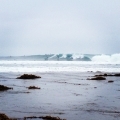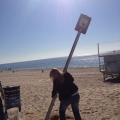The waves curl and crash ashore before slowly bubbling back to sea, a potion of water, foam and sand. The light of the full moon grazes the sandy beach at its feet while a bright Pacific breeze wanders through the night. There’s an air of romance. Thousands of wild fish certainly got the memo as they flop and dance around on the beach, performing one of nature’s most exceptional reproduction rituals.
If you’ve never witnessed a grunion run, you’ve been missing out on a classic Southern California beach tradition! Tonight and over the next few weeks you will have the rare opportunity to spot grunion coming to spawn.
Heal the Bay’s Marine Scientist Dana Murray answers some common questions about these special fish:
What are grunion?
Grunion are a sleek, silver fish that are most well known for their unique spawning behavior. These charismatic 6” fish surf the waves to shore, flop onto land to lay and fertilize eggs in the moonlight on our local beaches. Grunion are found in California (including Baja) and nowhere else in the world!
Why do they come to shore?
Grunion come to shore to lay their eggs at high tide. Spawning on sandy beaches, their eggs remain buried in the sand where they incubate for about two weeks until the next high tide comes and they hatch and return the ocean. The premier grunion expert in the world, Dr. Karen Martin, has written a book, “Beach-Spawning Fishes: Reproduction in an Endangered Ecosystem,” where you can read all about these fascinating fish.
When is the best time to try and see them?
At nighttime high tides during the spring and summer. Grunion may run as early as March on into September but peak season is from the start of April through June. Runs typically occur for a few nights after the highest tides during full and new moons. Your best chance to spot them is to plan ahead and stay out on the beach for an hour or so on either end of high tide.
Consult this grunion run 2017 schedule for the best times to observe these “silver surfers.”
What So Cal spots are best to try and spot them?
All you need is sand and a very high tide at night during grunion season! In the greater Los Angeles area, good grunion run locations include Surfrider in Malibu, Cabrillo Beach in Santa Pedro, Santa Monica State Beach, Hermosa Beach and Venice Beach.
What can I expect to see?
Although grunion sightings are never guaranteed, with a keen eye you can increase your chances. Look for predators such as black-crowned night herons or raccoons waiting for the surfing silversides along the shore. Some grunion runs are just a few scouts flopping onto the beach, whereas other runs involve thousands of fish, covering the wet sand entirely!
What should I do to prepare?
Bring warm clothes, your patience and a friend to walk the shoreline with. Leave your dog at home, and come knowing that as with any wildlife it’s a chance and not a guarantee that you’ll see them.
Are there things I shouldn’t do?
Do not to touch or interfere with spawning – especially during closed fishing season (April and May). Also, don’t shine lights on the water or grunion as it can interfere with their spawning, as can loud talking and noisy crowds.
Are grunions doing well? Are they in danger in any way?
The grunion population is believed to have decreased, so it’s important to protect them during spawning for the future population. Leaving domestic predators like dogs at home is advised, as canines may devour the eggs or disturb the fish. Also, not disturbing the buried grunion eggs along the high tide line after a spawning event helps ensure that grunion remain around into the future.
Dr. Karen Martin from Pepperdine University regularly works with and trains beach groomers to avoid the high tide line in grunion season, so as not to disturb eggs. Beach grooming operators now follow a specific protocol during grunion season to avoid disturbing sand where grunion eggs incubate.
How can I help grunion?
Observers of grunion runs are urged to report the time and location of the run for scientific purposes for Grunion Greeters.
Try not to disturb spawning grunion, and encourage others to do the same. During open season, follow the Fish and Game Regulations (which include not using any form of gear, nets or traps – only bare hands) and encourage observation or “catch and release.” If you observe poaching or any violations of grunion fishing regulations, such as use of gear or nets, please advise the California Department of Fish and Game or call 1-888-DFG-CALTIP.




 Staff scientist Dana Murray, center, helped install new signs in Malibu.
Staff scientist Dana Murray, center, helped install new signs in Malibu.
 It’s too bad the questionable water quality haunts the minds of most surfers at Malibu, which is why California Swimmable Day is important – it reminds us that all beaches should be safe for swimming, and that clean-up efforts at dirty beaches need to be implemented to meet this goal. Sometimes it’s hard to stay out of the surf after a rain, especially with a nice storm swell, but the risk versus reward has to be weighed.
It’s too bad the questionable water quality haunts the minds of most surfers at Malibu, which is why California Swimmable Day is important – it reminds us that all beaches should be safe for swimming, and that clean-up efforts at dirty beaches need to be implemented to meet this goal. Sometimes it’s hard to stay out of the surf after a rain, especially with a nice storm swell, but the risk versus reward has to be weighed.
